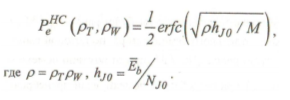In this article considered comparing the system with hybrid extensity on of spectrum PRWF-PRS in which carried out casual choice a sub-band from among available for transmission of one information symbol.
Keywords: spectral density, error probability, slow PRWF multi beam noise, active channel, average capacity of PJS, spectral density of NJC/2
The hindrance concentrated on a spectrum. Let the additive hindrance modeled of Gauss by casual process, with average capacity PJC is concentrated in strip WJ = ρW, 0 <ρ<1 and has bilateral spectral density NJC/2. We will consider a case slow PRWF, believing that for transfer of symbols of the message frequency modulation is used, and at demodulation the optimum not coherent algorithm is realized. In this case average value of probability of an error at demodulation of a symbol of the discrete message is equal:
 (1)
(1)
If spectral density NJC/2 of the hindrance concentrated on a spectrum essentially exceeds density N0/2 of thermal noise expression (1) assumes the following air:
 (2)
(2)
Optimum value ρ for which the probability of an error (2) is maximum, is by the equation decision:
 (3)
(3)
Optimum value ρопт appears equal:
 (4)
(4)
The maximum average value of probability of an error equally:
 (5)
(5)
Expressions (4), (5) are fair, if (РS/PJC) ∙ (W/Rb) ≥2. We will notice that the hindrance concentrated on a spectrum influences system with PRWF in the same way, as a faltering hindrance on system with direct expansion of a spectrum. Difference consists only that factor the security hindrance at identical values of a prize at processing and average probability of an error for system with PRWF appears on 6,5 дБ more low. However, it is necessary to mean that at use PRWF as a method of expansion of a spectrum, the strip of frequencies manages to be increased by some usages in comparison with direct expansion of a spectrum.
The reciprocal hindrance, hindrance is alot of beam
For struggle against a reciprocal hindrance and a hindrance much beam there is effective an application fast PRWF when for message transfer it is used NbL> 1 frequencies. Really, if duration of the Hardware of a frequency element (stay time for the fixed frequency) to choose it is less or equal to a difference of times of delay of signals at passage on a direct way and a way with re-reception or re-reflection the synthesizer of frequencies of the receiver will be reconstructed on other frequency of reception earlier, than the hindrance signal on corresponding frequency will arrive on an input of the receiver. Thus, if speed of re-organization of frequency to choose, proceeding from a condition that influence of a reciprocal hindrance or a hindrance much beam can be appreciable is weakened. Here τmin the minimum time of delay of a signal for ways with 63 re-reception (re-reflection), τ0 — time of delay of a signal at passage on a direct way. However the system with fast PRWF at action of thermal noise or the hindrance concentrated on a spectrum appears less noiseproof as at processing of signals with fast PRWF it is necessary to carry out not coherent accumulation Nb of elements of a signal during an interval of transfer of an element of the message.
![]() (6)
(6)
Mutualhindrances
Program reorganization of working frequency can be used at construction of systems CDMA. In this case each channel differs the program (law) of re-organization of working frequency, and, re-organization laws get out proceeding from demanded probability of coincidence of frequency elements. We will estimate a noise stability of synchronous system CDMA with PRWF, believing that in it is available To «active» channels. We will consider that quantity of working frequencies to equally M, and the probability of coincidence of useful and stirring signals is equal 1/М. At coincidence of frequencies of useful and stirring signals the probability of an error is equal 0,5. Certainly this pessimistic assumption, actually value of probability of an error appears less. As in systems with GRWF not coherent algorithm of demodulation the probability of an error at demodulation of a symbol of the message will be defined by following expression (7) more often is realized.
![]() (7)
(7)
Where Ph — probability of coincidence of working frequencies of useful and stirring signals. At presence (K-1) sources of a hindrance probability Ph is equal.
 (8)
(8)
 (9)
(9)
At value Eb/N0aspiring to infinity, we receive following expression for probability of an error.
![]() (10)
(10)
This size characterizes the so-called phenomenon of the «ineradicable» errors caused by presence of mutual hindrances. For achievement of small values of probability «ineradicable» шибок it is necessary to increase quantity of available frequency channels and to reduce quantity of «active» channels. In case of asynchronous system CDMA with PRWF the probability of coincidence of frequencies of useful and stirring signals is defined by following expression.
 (11)
(11)
Where Nb — quantity of the bats transferred on one working frequency
Comparing expressions (8) and (11), it is possible to establish, as asynchronous system probability of coincidence of frequencies of useful and stirring signals above, than in the synchronous. Substituting (9) in (5), we will receive following expression for probability of an error at demodulation of an element of the message in asynchronous system with CDMA with PRWF.
 (12)
(12)
In summary we will notice that in systems CDMA with PRWF the problem of a dynamic range of accepted signals is to a lesser degree shown. It is connected by that in various «active» channels the same working frequencies extremely seldom simultaneously are used. It arises only in case of insufficient frequency selectivity of filters.
Systems with direct expansion of aspectrum and signaling on the several bearing
Model of a hindrance As hindrance model we will use model limited on a strip of Gauss noise, and capacity of a hindrance is concentrated within a relative strip 0 <ρW <1, ρW=WJ/WPC and relative time 0 <ρт<1. A hindrance we will consider optimized iffor it such values of parametersρW and ρ T at which the probability of an error reaches the maximum value are chosen. We will consider that at hindrance action there is a full overlapping of a substrip (if it gets to the set substrip) and full overlapping of the time interval equal to duration of a symbol of the transferred message. Hence, if the hindrance blocks J substrips from M available the parameterspw is equal J/М. If PJ — a total power of an accepted hindrance its bilateral spectral capacity at continuous radiation is equal NJ0/2 =PJ/2Wpc. Then the bilateral spectral density of the hindrance concentrated on frequency and time, will be equal.
 (13)
(13)
In the first variant the algorithm of a combination with equal scales, in the second — algorithm of an optimum combination, in the third — algorithm motor combinations is realized.
Let the energy of a signal having on bit is equal to Eb. Then in each of M of substrips energy of signals will be equal Eb/ М, and the statistics on an exit of the separate demodulator on which decision Zi is passed will be equa l![]() in the absence of a hindrance
in the absence of a hindrance ) at hindrance influence if to neglect influence of own noise. Here N (a, σ2) of Gauss a random variable with a population mean and a dispersion equal and σ.
) at hindrance influence if to neglect influence of own noise. Here N (a, σ2) of Gauss a random variable with a population mean and a dispersion equal and σ.
For the channel with the relay frequency-selective to fade we will believe that the rating of the central frequencies of substrips is chosen such that to fade signals, rush to various substrips, are statistically independent.
For comparison we will consider system with the hybrid (combined) expansion of spectrum PRWF -PRS in which the casual choice of a substrip from among available for transfer of one information symbol is carried out. System with direct expansion of a spectrum and transfer on several bearing at ABSENCE замираний. The information on a channel condition is absent, rigid decisions are used. For the channel with the relay frequency-selective to fade we will believe that the rating of the central frequencies of substrips is chosen such that to fade the signals belonging to various substrips, are statistically independent. For comparison we will consider system with the hybrid (combined) expansion of spectrum PRWF -PRS in which the casual choice of a substrip from among available for transfer of one information symbol is carried out. System with direct expansion of a spectrum and transfer on several bearing at ABSENCE to fade. The information on a channel condition is absent, rigid decisions are used. The information on a channel condition specifies the term in in what of possible conditions there is each substrip, that is whether there is at it a hindrance, or not. As it will be shown more low, the faltering hindrance with full overlapping of all available strip ρW = 1) is optimum for all considered cases.
 (14)
(14)
Therefore with the full information on a condition канака it is not meaningful to consider a situation. We will believe here that in each separate demodulator which has been adjusted on "" bearing, the rigid preliminary decision concerning a transferred symbol of the message is passed, and the final decision is taken out on the basis of majority voting, that is the decision by the majority. In this case the probability of an error at removal of the preliminary decision will be defined by expression (14).







